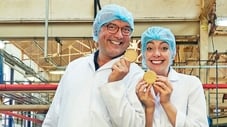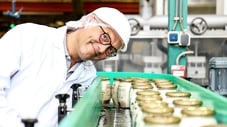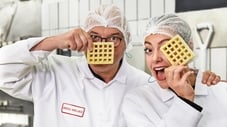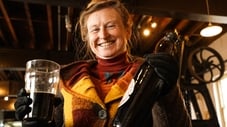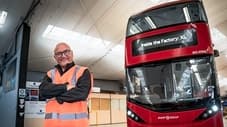
Inside the Factory (2015)
← Back to main
Michael Rees — Director
Episodes 14
Fish Fingers
Gregg Wallace explores the Grimsby factory that processes 165 tonnes of fish a week and produces 80,000 cod fish fingers every day.
Read MoreSoft Drinks
Gregg Wallace explores Ribena's Gloucestershire factory. Meanwhile, Cherry Healey is in the lab figuring out why fizzy drinks are so appealing.
Read MorePotato Waffles
How a factory in Lowestoft produces 450 tonnes of frozen food each day. The differences between waxy and floury potatoes, and which you should use for which job. How the potato's nutritional value compares to other fruits and vegetables. The history of potatoes is traced to Spanish explorers and an enterprising French chemist called Parmentier, who popularised the exotic new vegetable. How Mr Whippy ice creams inspired the potato waffle, a teatime treat.
Read MorePizza
How a factory in Italy produces 400,000 frozen pizzas each day. The science that makes mozzarella work so well on pizza. How pork is transformed into pepperoni. How freezer ships and trucks create the worldwide cold chain that enables this business to exist. How pizza was first popularised by a restaurant in London’s Soho in 1965
Read MoreBeer
How Britain's biggest brewery produces 3 million pints of beer a day in Burton upon Trent. How four basic ingredients – water, malted barley, hops and yeast – are manipulated to make dark, heavy ales; light, fragrant lagers; and everything in between. How the hard water of Burton – perfect for brewing flavourful stouts and porters – and its position on the canal network made it the centre of brewing in 19th-century Britain. How beer-making turned from a predominantly female cottage industry to an industrialised process dominated by men.
Read MorePencils
Gregg Wallace is in Germany at a historic pencil factory where they produce 600,000 writing implements a day. Cherry Healey examines the astonishing properties of graphite. Historian Ruth Goodman traces the origin of pencils to a 15th-century graphite discovery in the Borrowdale valley.
Read MoreCheese
How a cheese factory in Gateshead produces 3,000 tonnes of spreadable cheese every year - making cheddar, chopping and blending it with whey, water, and other ingredients. How bacteria affect the aroma, flavour and appearance of cheeses. How to make perfect cheese on toast. How cheddar became the predominant hard cheese world wide. How Kraft made processed cheese 100 years ago.
Read MoreDiggers
How JCB make as many as a hundred iconic yellow diggers every single day in Rocester, Staffordshire, requiring just 45 hours to make a digger from scratch, and consuming 650 tonnes of steel, 170,000 bolts, 5,000 litres of paint and 236 miles of wiring each week.
Read MoreTrains
How Alstom builds a 187-tonne, five-carriage electric train on their 84-acre site in Derby. How the train's aluminium is made at the UK's last remaining smelter in Scotland. How tunnel boring machines are digging ten miles through the hills for the new HS2 line. The history of the UK’s first electric train - Brighton's seafront tourist train, still used today - and how that technology went on to be used in underground transportation all over the world.
Read MoreBuses
How London's famous red double-decker bus - including a fully electric model - is built in Scarborough, Yorkshire, highlighting the tough laminated heated windscreens and bright red coat of paint. How the turbines at an offshore wind farm convert wind into watts. The history of London's earliest double-deckers and their vital role in the First World War.
Read More

